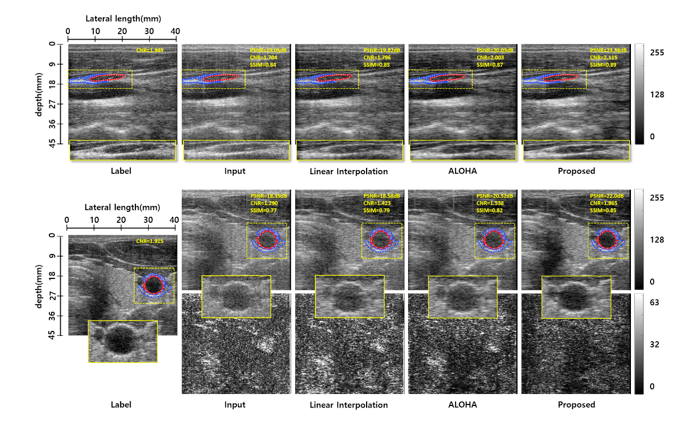In portable, 3D, and ultra-fast ultrasound imaging systems, there is increasing demand for the reconstruction of high quality images from a limited number of radio-frequency (RF) measurements due to receiver (Rx) or transmit (Xmit) event sub-sampling. However, due to the presence of side lobe artifacts from RF sub-sampling, the standard beam-former often produces blurry images with less contrast, which are unsuitable for diagnostic purposes. Existing compressed sensing approaches often require either hardware changes or computationally expensive algorithms, but their quality improvements are limited. To address this problem, Professor Jong Chul Ye’s research team designed a novel deep learning method that directly interpolates the missing RF data by utilizing redundancy in the Rx-Xmit plane. The proposed method can effectively accelerate the acquisition process by reducing the number of transmit events without sacrificing image quality.

The proposed novel deep learning approach for accelerated B-mode ultrasound imaging is inspired by the recent discovery of a close link between deep neural networks and Hankel matrix decomposition, and the authors searched for a signal domain in which the Hankel structured matrix is sufficiently low-ranked. The analysis showed that there are significant redundancies in the Rx-Xmit and Rx-SL domains, which results in a low-rank Hankel matrix. Thus, to exploit the redundancy in the RF domain, the proposed CNN was applied to the Rx-Xmit domains. In contrast to existing CS approaches that require hardware changes or computationally expensive algorithms, the proposed method does not require any hardware change and can be applied to any B-mode ultrasound system or transducer. Moreover, as a result of the exponentially increasing expressiveness of deep networks, PSNR, SSIM, and CNR were significantly improved over other existing methods (see Figure 1), and the run-time complexity was orders of magnitude faster. This method can provide an important platform for RF sub-sampled US imaging.
This research appeared at IEEE Trans. On Medical Imaging.
Jongchul Ye (Department of Bio and Brain Engineering)
Homepage: http://www.bispl.weebly.com
E-mail: jong.ye@kaist.ac.kr






